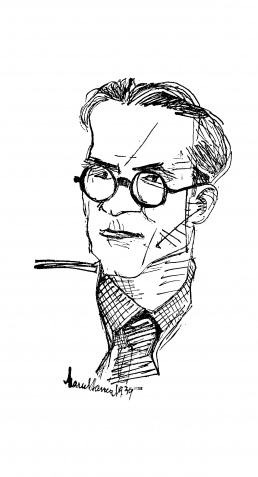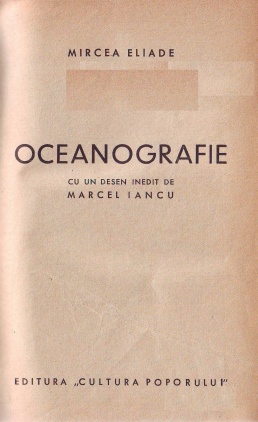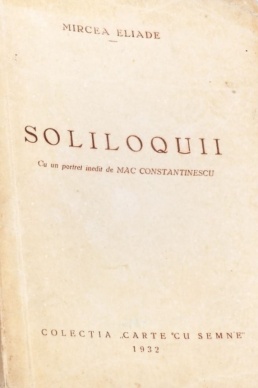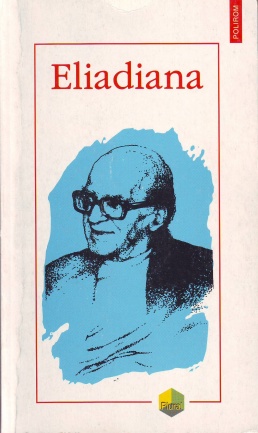Difference between revisions of "Mircea Eliade"
Sorindanut (talk | contribs) |
Sorindanut (talk | contribs) |
||
| Line 322: | Line 322: | ||
* Mircea Handoca (ed.), ''Mircea Eliade şi corespondenţii săi'', 5 vols., Bucharest: Minerva, 1993-2007. | * Mircea Handoca (ed.), ''Mircea Eliade şi corespondenţii săi'', 5 vols., Bucharest: Minerva, 1993-2007. | ||
| − | * N. Spineto (ed.), ''Mircea Eliade | + | * N. Spineto (ed.), ''Mircea Eliade- Raffaele Pettazzoni. L'histoire des religions a-t-elle un sens? Correspondance 1926-1959'', Paris, 1994. {{fr}} |
* ''Jurnalul portughez şi alte scrieri (1941-1945)'' , 2 vols., Bucharest: Humanitas, 2006. [http://www.philologica-jassyensia.ro/upload/IV_1_Antofi.pdf Review], [http://www.romlit.ro/mircea_eliade_jurnalul_portughez Review]. | * ''Jurnalul portughez şi alte scrieri (1941-1945)'' , 2 vols., Bucharest: Humanitas, 2006. [http://www.philologica-jassyensia.ro/upload/IV_1_Antofi.pdf Review], [http://www.romlit.ro/mircea_eliade_jurnalul_portughez Review]. | ||
| Line 331: | Line 331: | ||
* Julius Evola, ''Lettere a Mircea Eliade. 1930-1954'', intro Claudio Mutti, Controcorrente, Naples. Quaderni di testi evoliani n. 46. Fondazione Julius Evola, 2011, 88 pp. {{it}} | * Julius Evola, ''Lettere a Mircea Eliade. 1930-1954'', intro Claudio Mutti, Controcorrente, Naples. Quaderni di testi evoliani n. 46. Fondazione Julius Evola, 2011, 88 pp. {{it}} | ||
| + | |||
| + | * ''Întotdeauna Oriental: Corespondenţă Mircea Eliade-Stig Wikander: 1948-1977'', Iaşi: Polirom, 2005. | ||
==Diaries== | ==Diaries== | ||
Revision as of 13:20, 26 August 2019
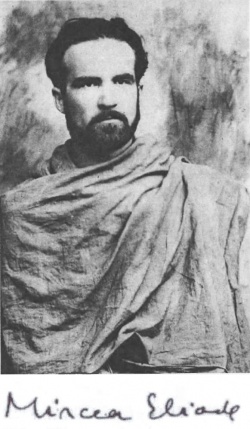 Mircea Eliade, december 1930, Rishikesh, Himalayas. | |
| Born |
March 9, 1907 Bucharest, Romania |
|---|---|
| Died |
April 22, 1986 (aged 79) Chicago, USA |
| Web | Open Library |
Mircea Eliade (1907–1986) was a Romanian historian of religion, fiction writer, philosopher, and professor at the University of Chicago. He is known for his research of the symbolic language used by various religious traditions.
Eliade received an M.A. in philosophy from the University of Bucharest in 1928. He studied Sanskrit and Indian philosophy at the University of Calcutta (1928-31) and then lived for six months in the Ashram (hermitage) of Rishikesh, Himalayas. After returning to Romania, he earned his Ph.D. in 1933 with the dissertation Yoga: Essai sur les origines de la mystique indienne [Yoga: Essay on the Origins of Indian Mysticism] and was named assistant professor at Bucharest, where he taught the history of religions and Indian philosophy (1933-39). In 1945 he went to Paris as a visiting professor at the École des Hautes Études of the Sorbonne. In 1956 he became professor of the history of religions at the University of Chicago. In 1961 he founded the journal History of Religions.
Contents
Biography
(Adapted from "Mircea Eliade" by Bryan Rennie in the 1998 Routledge Encyclopedia of Philosophy)
- Life
Mircea Eliade was born in Bucharest, Romania. Despite a childhood interest in entomology and botany (which doubtless first attracted his attention to Goethe, a lifelong role model and inspiration), he developed an interest in world literature and was led from there to philology, philosophy, and comparative religion. As a youth he read extensively in Romanian, French, and German, and around 1924-25 he learned Italian and English to read Raffaele Pettazzoni and James George Frazer in the original.
In 1925 Eliade enrolled at the University of Bucharest where he studied in the department of philosophy. The influence of Nae Ionescu (b. 1890), then an assistant professor of logic and metaphysics and an active journalist, was keenly felt by the young Eliade and the shadow which fell on the older scholar because of his involvement with the extreme right in inter-war Romania has darkened Eliade's reputation.
Eliade's Master's thesis examined Italian Renaissance Philosophers from Marcilio Ficino to Giordano Bruno, and Renaissance Humanism was one of his major influences when he turned to India in order to "universalize" the "provincial" philosophy he had inherited from his European education. Finding that the Maharaja of Kassimbazar sponsored European scholars to study in India Eliade applied and was granted an allowance for four years. In 1928 he sailed for Calcutta to study Sanskrit and philosophy under Surendranath Dasgupta (1885-1952), a Cambridge educated Bengali, professor at the University of Calcutta, and author of a 5 volume, History of Indian Philosophy (Motilal Banarsidass 1922-55).
He returned to Bucharest in 1932 and successfully submitted his analysis of Yoga as his doctoral thesis at the Philosophy department in 1933. Published in French as Yoga: Essai sur les origines de la mystique Indienne this was extensively revised and republished as Yoga, Immortality, and Freedom. As Ionescu's assistant Eliade lectured on, among other things, Aristotle's Metaphysics and Nicholas of Cusa's Docta Ignorantia. From 1933 to 1939 he was active with the Criterion group who gave public seminars on wide-ranging topics. They were strongly influenced by the philosophy of "trăirism," the search for the "authentic" in and through lived experience (Romanian word, "trăire") seen as the only source of "authenticity".
After the Second World War, during which he served with the Romanian Legation in the UK and Portugal, Eliade was unable to return to the newly communist Romania because of his connection with the right-wing Ionescu. In 1945 he moved to Paris where his acquaintance with Georges Dumézil, an important scholar of comparative mythology, secured a part-time post for him at the École des Hautes Études at the Sorbonne teaching comparative religion. From this time on almost all of Eliade's scholarly works were written in French.
At the prompting of Joachim Wach, Eliade's predecessor at the University of Chicago, a comparativist and hermeneuticist, Eliade was invited to give the 1956 Haskell Lectures on "Patterns of Initiation" at the University of Chicago. These were later published as Birth and Rebirth. In 1958 he was invited to assume the chair of the History of Religions department in Chicago. There he stayed until his death in 1986, publishing extensively and writing largely unpublished fiction. He also launched the journals History of Religions and The Journal of Religion and acted as editor-in-chief for Macmillan's Encyclopedia of Religion.
- Thought
Despite his focus on the history of religions, Eliade never relinquished his philosophical agenda. That said, he never fully clarified his philosophy. There has been radical disagreement over his thought, some seeing it as a crucial contribution to the study of religion, and some seeing him as an obscurantist whose normative assumptions are unacceptable.
In Cosmos and History: The Myth of the Eternal Return (1954), a book which he was tempted to subtitle Introduction to a Philosophy of History, Eliade distinguishes between religious and non-religious humanity on the basis of the perception of time as heterogenous and homogenous respectively. This distinction will be immediately familiar to students of Henri Bergson as an element of that philosopher's analysis of time and space. Eliade contends that the perception of time as an homogenous, linear, and unrepeatable medium is a peculiarity of modern and non-religious humanity. Archaic or religious humanity (homo religiosus), in comparison, perceives time as heterogenous; that is, as divided between profane time (linear), and sacred time (cyclical and reactualizable). By means of myths and rituals which give access to this sacred time religious humanity protects itself against the 'terror of history', a condition of helplessness before the absolute data of historical time, a form of existential anxiety.
In the very process of establishing this distinction, however, Eliade undermines it, insisting that non-religious humanity in any pure sense is a very rare phenomenon. Myth and illud tempus are still operative, albeit concealed, in the world of modern humanity and Eliade clearly regards the attempt to restrict real time to linear historical time as finally self-contradictory. He squarely sets himself against the historicism of Hegel.
"The sacred" has also been the subject of considerable contention. Some have seen Eliade's "sacred" as simply corresponding to a conventional concept of deity, or to Rudolf Otto's ganz andere (the "wholly other"), whereas others have seen a closer resemblance to Emile Durkheim's socially influenced sacred. Eliade himself repeatedly identifies the sacred as the real, yet he states clearly that "the sacred is a structure of human consciousness" (1969 i; 1978, xiii). This would argue more for the latter interpretation: a social construction of both the sacred and of reality. Yet the sacred is identified as the source of significance, meaning, power and being, and its manifestations as hierophanies, cratophanies, or ontophanies accordingly (appearances of the holy, of power, or of being). Corresponding to the suggested ambiguity of the sacred itself is the ambiguity of its manifestations.
Eliade does state that believers for whom the hierophany is a revelation of the sacred must be prepared by their experience, including their traditional religious background, before they can apprehend it. To others the sacred tree, for example, remains simply a tree. It is an indispensable element of Eliade's analysis that any phenomenal entity could be apprehended as an hierophany with the appropriate preparation. The conclusion must be that all beings reveal, and at the same time conceal, the nature of Being. A reprise of Nicholas of Cusa's Coincidentia Oppositorum is evident here, as is a possible explanation of the systematic ambiguity of Eliade's writings.
Finally religion, systematically understood as the apprehension of relative worth conferred through non-historical realities (including all abstract and imaginary entities) but revealed and confirmed through historical phenomena is seen as a unifying human universal. It is characteristic of Eliade's style of writing, both in his fictional and in his academic work, that this conclusion is nowhere clearly stated. Leading assertions are scattered throughout his publications on the history of religions, alchemy, symbolism, initiation, myth, etc. inviting his readers either to make an immediate interpretation or to pursue the question further into the thicket of his oeuvre.
Works
| Works are in Romanian unless otherwise stated. Green and blue links point to digital versions of publications available on Monoskop or other digital libraries (sometimes using abbreviations). |
Scholarly works
Thesis
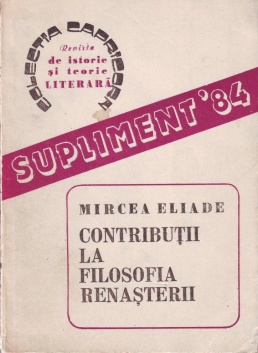
- Contribuții la filosofia Renașterii, Bucharest, thesis presented in 1928 (see below); reprint as Contribuții la filosofia Renașterii. [Itinerar italian], edition by Constantin Popescu-Cadem; intro Zoe Dumitrescu-Bușulenga, Bucharest: Academiei RSR, 1984, PDF, PDF, IA, ARG. Excepts
- Yoga. Essai sur les origines de la mystique indienne, Paris: Librairie Orientaliste Paul Guethner, 1936 (PhD. thesis presented in Bucharest in 1933). (French)
Monographs
- O, Oceanografie, Bucharest: Cultura Poporului, 1st edition, 1934, PDF, PDF, IA, ARG; reprint, Bucharest: Humanitas, 1991, 214 pp. Excerpts
- Oceanografia, Roberto Scagno (editor), intro R. Scagno, trans. Cristina Fantechi, Milan: Jaca Book, 2007. (Italian)
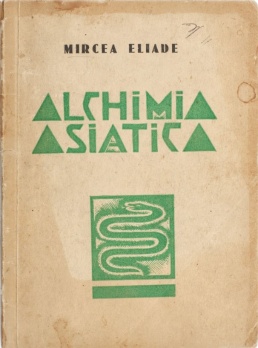
- AA, Alchimia asiatică, Bucharest: Cultura Poporului, 1934; reprint, Bucharest: Humanitas, 1991, 2003, PDF, IA, ARG.
- Il mito dell’alchimia seguito da L’alchimia asiatica, trans. G. Brivio, Turin: Bollati Boringhieri, 2001, PDF. (Italian)
- CAB, Cosmologie şi alchimie babiloniană, 1937; 2nd ed., Iaşi: Moldova, 1991, PDF, PDF, IA, ARG.
- Cosmologia e alchimia babilonesi, trans. Alba Rosa Leone, Florence: Sansori, 1992, PDF. (Italian)
- MMA, Metallurgy, Magic, and Alchemy, Cahiers de Zalmoxis, Paris: Librairie orientaliste Paul Guenther, 1938. (English)
- F, Fragmentarium, Bucharest: Vremea, 1939; reprint, Deva: Destin, Deva, 1990; reprint as Fragmentarium. Note şi eseuri Bucharest: Humanitas, 1992; 1994; 2003, HTML; 2008.
- Fragmentarium, trans. Alain Paruit, L'herne, 1989. (French)
- Fragmentarium, trans. Cristina Fantechi, Milan: Jaca Book, 2008. (Italian)
- MR, Mitul reintegrării, Bucharest: Vremea, 1942.
- Il mito della reintegrazione, Milan: Jaca Book: 1989. (Italian)
- TY, Techniques du Yoga, Paris: Gallimard, 1948. (French)
- Tehnici Yoga, trans. Mihaela Cosmna, Bucharest: Univers Enciclopedic, 2000, PDF.
- THR, Traité d'histoire des religions, intro Georges Dumézil, Paris: Payot, 1949; 1964. (French)
- Patterns of Comparative Religion, trans. Rosemary Sheed, London: Sheed and Ward, 1958, ARG. (English)
- Trattato di storia delle religioni, trans. Virginia Vacca, Turin: Editore Boringhieri, 1976, PDF. (Italian)
- Tratat de istorie a religiilor, trad. Mariana Noica, Bucharest: Humanitas, 1992, ARG; 5th ed, 2013.
- MER, Le Mythe de l'éternel retour. Archétypes et répétition, Paris: Gallimard, 1949. (French)
- Cosmos and History: The Myth of the Eternal Return, trans. Willard R. Trask, Pantheon Books, 1954; New York: Harper & Brothers, 1959, PDF. (English)
- Il mito dell'eterno ritorno: archetipi e ripetizione, trans. Giovanni Cantoni, Rome: Borla, 1966; Turin: Boria, 1968; 1975, PDF, IA, PDF. (Italian)
- Mito do eterno retorno, trans. José A. Ceschin, Sao Paulo: Mercuryo, 1992, PDF, ARG. (Brazilian Portuguese)
- El mito del eterno retorno. Arquetipos y repeticion, trans. Ricardo Anaya, Buenos Aires: Emecé, 2001, PDF. (Spanish)
- Mitul eternei reîntoarceri. Arhetipuri şi repetare, trans. Maria Ivănescu & Cezar Ivănescu, Bucharest: Univers Enciclopedic, 1999, PDF.
- CTAE, Le Chamanisme et les techniques archaiques de l'extase, Paris: Payot, 1951; 2nd ed., 1968, IA; 1974; 1978; 1983. (French)
- Lo sciamanismo e le tecniche dell'estasi, trans. R. Rambelli, Rome: Edizioni Mediterranee, 1974; 1975; 2002, PDF. (Italian)
- Şamanismul şi tehnicile arhaice ale extazului, trans. Brînduşa Prelipceanu and Cezar Baltag, Bucharest: Humanitas, 1997, PDF.
- Shamanism: Archaic Techniques of Ecstasy, trans. Willard Trask, London: Routledge & Kegan Paul, 1964. (English)
- IS, Images et Symboles. Essais sur le symbolisme magico-religieux, Paris: Gallimard, 1952. (French)
- FA, Forgerons et alchimistes, Paris: Flammarion, 1956; 1977. (French)
- The Forge and the Crucible, trans. Stephen Corrin, London: Rider, 1962. (English)
- Făurari şi alchimişti, trans. Maria Ivănescu and Cezar Ivănescu, Bucharest: Humanitas, 1996, PDF.
- MRM, Mythes, rêves et mystères, Paris: Gallimard, 1957. (French)
- Myths, Dreams and Mysteries: The Encounter between Contemporary Faiths and Archaic Realities, London: Harvill Press, 1960. (English)
- Mituri, vise şi mistere, trans. Maria Ivănescu and Cezar Ivănescu, Bucharest: Univers Enciclopedic, 1998, PDF.
- SP, Das Heilige und das Profane, 1957. (German)
- The Sacred and the Profane: The Nature of Religion, trans. Willard R. Trask, London: Harcourt Brace Jovanovich, 1959; 1963, PDF. [1] (English)
- Il sacro e il profano, Turin: Bollati Boringhieri, 1973. (Italian)
- O sagrado e o profano, trans. Rogério Fernandes, Sao Paulo: Martins Fontes, 1992, PDF, IA, ARG. (Brazilian Portuguese)
- Le sacré et le profane, Paris: Gallimard, 1965, PDF; Paris: Folio, 1988. (French)
- Sacrul şi profanul, trans. Brânduşa Prelipceanu, Bucharest: Humanitas, 2000, PDF; 3rd ed., 2005, IA.
- NM, Naissances mystiques. Essai sur quelques types d'initiation, Paris: Gallimard, 1958. (French)
- Birth and Rebirth, trans. Willard R. Trask, London: Harvill Press/Harper & Brothers, 1958; reprint as Rites and Symbols of Inititation. The Mysteries of Birth and Rebirth, New York: Harper & Row, 1975, PDF, IA, ARG. His 1956 Haskell Lectures at the University of Chicago. (English)
- Naşteri mistice, trans. Mihaela Grigore Paraschivescu, Bucharest: Humanitas, 1995, PDF.
- PY, Patanjali et le Yoga, Paris: Seuil, 1962. (French)
- MA, Méphisophélès et l'androgyne, Paris: Gallimard, 1962. (French)
- The Two and the One, trans. J. M. Cohen, University of Chicago Press, 1965. (English)
- Mefistofele e l'androgino, trans. Enrico Pinto, Rome: Edizioni Mediterranee, 1971; reprint, 1995, PDF. (Italian)
- Mefistotel şi androginul, trans. Alexandra Cuniţă, Bucharest: Humanitas, 1995, PDF.
- Mefistofele e l'androgine, trans. Enrico Pinto, Rome: Mediterranne, 1971; 1995, PDF. (Italian)
- AM, Aspects du mythe, Paris: Gallimard, 1963. (French)
- Myth and Reality, trans. and redactor Ruth Nanda Anshen, New York: Harper & Row, 1963. (English)
- Mito e realtà, trans. Giovanni Cantoni, Turin: Boria, 1966, PDF, IA (Italian)
- Aspecte ale mitului, trans. Paul G. Dinopol, intro. Vasile Nicolescu, Bucharest: Univers, 1978, PDF, PDF, IA, ARG.
- Aspektue mifa, 2000, PDF; Moscow: Академический Проект 2010. (Russian)
- 'Aspekti Mita, trans. Natasa Pejovic, Zagreb: Demetra, 2004, PDF. (Croatian)
- FPTZ, From Primitives to Zen. A Sourcebook in Comparative Religion, New York: Harper & Row, 1967; Nebulous Cargo, 1996. HTML. (English)
- NO, The Quest: History and Meaning in Religion, Chicago and London: University of Chicago Press, 1969; reprint, Midway, 1984, PDF. (English)
- ZGK, De Zalmoxis a Gengis-Khan, Paris: Payot, 1970. (French)
- Da Zalmoxis a Gengis-Khan, trans. Alberto Sobrero, Rome: Casa Editrice Astrolabio-Ubaldini Editore, 1975, PDF, PDF. (Italian)
- De la Zalmoxis la Ghenghis-Han. Studii comparatice despre religiile şi folclorul Daciei şi Europei Orientale, trans. Maria Ivănescu and Cezar Ivănescu, Bucharest: Ştiinţifică şi Enciclopedică, 1980; Bucharest: Humanitas, 1995, PDF, PDF, IA.
- Zalmoxis, the Vanishing God, trans. Willard Trask, University of Chicago Press, 1972. (English)
- RA, Australian Religion, intro. Victor Turner, Cornell: Cornell University Press, 1973. Based on a conference on held at Universiy of Chicago, 1964. (English)
- Occultism, Occultism, Witchcraft, and Cultural Fashion: Essays in Comparative Religion, Chicago and London: University of Chicago Press, 1976; 1978, PDF, PDF. (English)
- Occultisme, sorcellerie et modes culturelles, 1978. (French)
- Occultismo, stregoneria e mode culturali: saggi di religioni comparate, [Firenze]: Sansoni, [1984]. (Italian)
- Ocultism, vrăjitorie şi mode culturale. Eseuri de religie comparată, trans. Elena Bortă, Bucharest: Humanitas, 1997, PDF.
- HCIR, Histoire des croyances el des idees religieuses, vol. 1, De l'âge de la pierre aux mystères d’Eleusis, 1976; vol. 2, De Gautama Bouddha au triomphe du christianisme, 1976; vol. 3, De Mahomet à l’âge des Réformes, 1983; Paris: Payot, 1976-83. (French)
- A History of Religious Ideas, trans. Willard R. Trask, Chicago and London: The University of Chicago Press, vol. I, 1978, PDF; vol. II, 1982, PDF ; vol. III, trans. Alf Hiltebeitel and Diane Apostolos-Cappadona, 1985; 1988, PDF. (English)
- Historia de las creencias y las ideas religiosas, 4 vols., trans. Jesús Valiente Malla, Madrid: Cristiandad, 1978-80; Barcelona: Paidós Ibérica, 1999. I, De La Edad De Piedra a Los Misterios De Eleusis Orientalia, PDF, PDF; II, De Gautama Buda al triunfo del cristianismo, PDF, PDF; III, De Mahoma a la era de las Reformas, PDF, PDF; IV, Las Religiones en sus textos, PDF, PDF. (Spanish)
- Istoria credinţelor şi ideilor religioase, trans. Cezar Baltag, Bucharest: Univers Enciclopedic, 2000, 800 pp, IA.
Selected essays
- Soliloquii/ Solilocvii, Bucharest: Inst. de arte Grafice "Bucovina", I.E. Torouţiu, 1932; reprint, as a supplement of magazine "Nu", Cluj, 1990; reprint as book, Bucharest: Humanitas, 1991; 2003, PDF, PDF, IA, ARG.
- Yoga. Eseu asupra originilor misticii indiene, trans. Mircea Eliade, Bucharest: Fundaţia pentru Literatură şi Artă Regele Carol II, 1936.
- Yoga. Immortality and Freedom, trans. Willard Trask, London: Routledge & Kegan Paul, 1958, PDF; 2nd ed., London: Routledge, 1969. (English)
- Yoga. Unsterblichkeit und Freiheit, Zürich and Stuttgart: Rascher, 1960. (German)
- Yoga. Nemurire şi libertate, trans. Walter Fotescu, Bucharest: Humanitas, 1993, PDF.
- Comentarii la Legenda Meşterului Manole, Bucharest: Editura Publicom, 1943, PDF, ARG; new ed, notes by Magda and Petru Ursache, Iași: Junimea, 1992; Bucharest: Humanitas, 2004, 144 p.
- Insula lui Euthanasius, Bucharest: Fundaţia Regală pentru Literatura şi Artă, 1943.
- Despre Eminescu şi Haşdeu:[Studiu], Iaşi: Junimea, 1987.
- Fragmenatrium, Bucharest: Humanitas, 1994.
Theater
- Coloana nesfârşită: Teatru (Iphigenia "1241"). Oameni şi pietre. Coloana nesfârşită), Bucharest: Minerva, 1996.
Selected articles
- "Theories of Primitive Religion. E.E. Evans-PRITCHARD", American Anhropologist, vol. 68, issue 6, 1966, pp 1518--1519, PDF. Review. (English)
Edited books
- Bogdan Petriceicu-Hasdeu, Scrieri literare, morale și politice, 2 vols., critical editions, and notes by Mircea Eliade, Bucharest: Fundația pentru Literatură și Artă "Regele Carol II", 1937, tom. I, 473 p; tom. II, 413 p.
- Profetism românesc, 2 vols., Bucharest: Roza vânturilor, 1990. Contains essays published 1927-1938.
- Morfologia religiilor: Prolegomene, intro Mircea Handoca and Dan Petraşincu, ed. Manuela Tănăsescu, Bucharest: Jurnalul literar, 1993, 248 p.
- Misterele şi iniţierea orientală: Scrieri de tinereţe [1926], ed. and notes by Mircea Handoca, Bucharest: Humanitas, 1998, 335 p.
- (editor in chief), with Charles J. Adams, editors and others, Encyclopedia of Religion, 16 vols., New York: Macmillan, 1987, 4507 pp, vol. 1-15. A-Z; vol. 16. Index.; 16 Vols. in 8, MacMillan Reference Books (January) 1993. (English)
- Enciclopedia delle religioni, Dario M. Cosi, Luigi Saibene, Roberto Scagno (eds.), 17 vols., Milan: Jaca book, 1993-2012. (Italian)
- Volume 1, Oggetto e modalità della credenza religiosa, 1993, 613 pp, PDF, PDF;
- Volume 2, Il rito. Oggetti, atti, cerimonie, 1994, 634 pp, PDF, PDF;
- Volume 3, L'Esperienza. Vita religiosa, individuale e collettiva, 1996, 716 pp, PDF,PDF;
- Volume 4, Il Pensiero. Concezioni e simboli, Marzorati/ Jaca book, 1997, 683 pp, PDF, PDF;
- Volume 5, Lo studio delle religioni. Discipline e autori, Marzorati/ Jaca book, 1995, 643 pp, PDF, PDF;
- Volume 6, Ebraismo, Città Nuova/ Jaca book, 2003, 779 pp, PDF, PDF;
- Volume 7, CRISTIANESIMO;
- Volume 8, Islam, Città Nuova/ Jaca book, 2004, 718 pp, PDF, PDF;
- Volume 9, Induismo, Città Nuova/ Jaca book, 2006, 514 pp, PDF, PDF;
- Volume 10, Buddhismo, Città Nuova/ Jaca book, 2006, 730 pp, PDF, PDF;
- Volume 11, Religioni del Mediterraneo e del Vicino Oriente Antico, Città Nuova/ Jaca book, 2002, 578 pp, PDF,PDF;
- Volume 12, Religioni dell'Eurasia, Città Nuova/ Jaca book, 2007, 360 pp, PDF, PDF;
- Volume 13, Religioni dell'Estremo Oriente, Città Nuova/ Jaca book, 2007, 621 pp, PDF, PDF
- Volume 14, Religioni dell'Africa, Città Nuova/ Jaca book, 2009, 311 pp, PDF, PDF;
- Volume 15, Religioni dell'Oceania, Città Nuova/ Jaca book, 2012, 306 pp, PDF, PDF;
- Volume 16, Religioni delle Americhe, Città Nuova/ Jaca book, 2010, 615 pp, PDF, PDF;
- Volume 17, Indici.
- Enciclopedia delle religioni, Dario M. Cosi, Luigi Saibene, Roberto Scagno (eds.), 17 vols., Milan: Jaca book, 1993-2012. (Italian)
- with Ioan P. Couliano, Dictionnaire des religions, Paris: Plon, 1990, PDF. (French)
- Religioni: dizionario, Milan: Jaca book, 1992, 415 pp, (Italian)
- Dicţionar al religiilor, trans. Cezar Baltag, Bucharest: Humanitas, 1993, PDF, ARG, new ed, with collaboration H.S. Wiesner, trans. Dan Petrescu, Iași: Polirom, 2007. Translated from the french version.
- with Hillary Wiesner, The Eliade Guide to World Religions, 1992; reprint as, The Harper Collins Concise Guide to World Religions, 2000. (English)
- Psihologia meditaţiei indiene. Studii despre Yoga, Bucharest: Jurnalul Literar, 1992, PDF.
Selected works
- Symbolism, the Sacred and the Arts, editor Diane Apostolos-Cappadona, New York: Crossroad, 1985; reprint, Continuum, 1992. (English)
- Yoga, intro Constantin Noica, editors Mircea Handoca and Constantin Noica, Craiova: Mariana, 1991, 110 p, ARG.
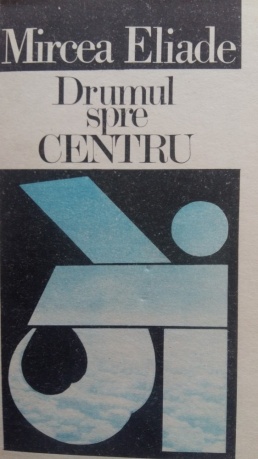
- Drumul spre centru, eds. Gabriel Liiceanu and Andrei Pleşu, Bucharest: Univers, Humanitas, 1991, PDF, PDF, IA, ARG. Contains Oceanografie, Fragmentarium, Insula lui Euthanasius, Mitul reintegrării, Comentarii la Legenda Meşterului Manole & Alchimia asiatică.
- Cum am găsit piatra filozofală: Scrieri de tinereţe 1921-1925, Bucharest: Humanitas, 1996.
- Eliadiana, critical ed. Cristian Badiliță, Iași: Polirom, 1997, PDF.
- Sull’Erotica mistica Indiana e altri scritti, trans. Guido Brivio Gabutti Di Bestagno, Rome/Turin: Bollati Boringhieri, 1998, 99 pp. (Italian)
- Note asupra simbolismului acvatic, edition by Georg Lecca, trans. Lucia Zaharescu, intro Marcel Tolcea, Timişoara/ Cluj: Fundaţia Interart TRIADE/ IDEA Design & Print, 2002.
- Meşterul Manole. Studii de etnologie şi mitologie, selected anthology and notes Magda Ursache and Petru Ursache, Cluj-Napoca: Eikon, Cluj-Napoca, 2008.
Colected works
- Opere, vol. I, edition by Mihai Dascăl, Bucharest: Minerva, 1994.
Fiction
Novels
- Isabel şi apele diavolului, Bucharest: Naţionala-Ciornei, 1930, 236 p; 2nd edition, 1932.
- Într'o mănăstire din Himalaya, Bucharest: Cartea Românească, 1932, 32 p.
- Maitreyi, Bucharest: Naţionala-Ciornei, 1933.
- La Nuit Bengali, Paris: Gallimard, 1950. (French)
- Mayitreyi, Bengal Nights, 1993. (English)
- Întoarcerea din Rai [Return from Heaven], Bucharest: Naţională-Ciornei, 1934, 419 p.
- Lumina ce se stinge, Bucharest: Cartea Românească, 1934, 414 p; reprint, Bucharest: Humanitas, 1998.
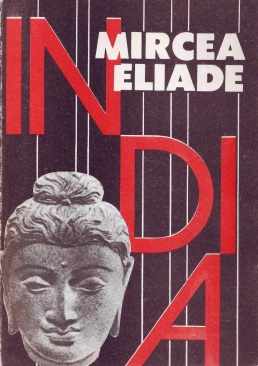
- India, Bucaharest: Cugetarea, 1934, 279 p; 2nd edition, Georgescu-Delafras, 1935; reprint, ed. Mircea Handoca, Bucharest: Editura pentru Turism, 1991, PDF, IA, IA, PDF, ARG; new ed., Bucahest: Humanitas, 1998.
- Șantier, jurnal indian, Bucaharest: Cugetarea, 1935, 276 p.
- Huliganii, 2 vols., Bucharest: Naţională-Ciornei, 1935, 270 p, 280 p.
- Domnişoara Christina [Miss Christina], Bucharet: Cultura Naţională, 1936, 260 p.
- Şarpele, Bucharet: Naţională-Ciornei, 1937, 240 p.
- Nuntă în cer, Bucharest: Cugetarea, 1938, 280 p; reprint, Bucharest: Minerva, 1986; Bucharest: Humanitas, 2003; Muşăteşti: Tana, 2007. Review
- Forêt interdite, Paris: Gallimard, 1955. (French)
- Noaptea de Sânziene, 1971.
- The Forbidden Forest, 1978. (English)
- Isabel şi apele diavolului, 1932.
- Isabel and the Devil's Waters. (English)
- Tinereţi fără de Tinereţi, in Revista scriitilorilor români, 15 (1978), pp 49-82, and 16 (1979), pp 33-73.
- Le Temps d’un centenaire, Paris: Gallimard, 1982. (French)
- Youth Without Youth, trans. Mac Linscott Ricketts, Ohio State University Press, 1988; University of Chicago Press, 2007, IA. (English)
- Romanul Adolescentului Miop & Gaudeamus, Bucharest: Minerva, 1989; Bucharest: Litera, 2009. Ten chapters of Romanul.. first appeared serialized in the magazine Manuscriptum (2-4/1983 and 1/1987). Gaudeamus was first published by Muzeul Literaturii Române in 1988.
Bibliographies
Printed
- Mircea Eliade: a check-list of his publications in the history of religions, compiled by Ann Pritchard and D.E. Fitch, Santa Barbara : University of California Library, 1968. (English)
- Joseph M. Kitagawa and Charles H. (eds.), Myths and Symbols. Studies in Honor of Mircea Eliade, Chicago and London: University of Chicago Press, 1969, pp. 417-433. (English)
- D.A. Doing, A Biography of Mircea Eliade's Spiritual and Intellectual Development from 1917 to 1940, University of Ottawa, 1975, pp. I-LXXXIII. (Phd Thesis) (English)
- R.W. Kraay, Symbols in Paradox: A Theory of Communication based on the Writings of Mircea Eliade, Iowa University, 1977. (Phd Thesis) (English)
- Mircea Handoca, Mircea Eliade: contribut̡ii biobliografice, Bucharest: Societatea literară Relief românesc, 1980, 239 pp.
- Douglas Allen, Denis Doeing, Mircea Eliade. An Annotated Bibliography, New York and London: Garland, 1980. (English)
- "Opera lui Mircea Eliade în ordinea publicării ei", established by Doina Cornea, in: Mircea Eliade, Încercarea labirintului, trans. Doina Cornea, Cluj-Napoca: Dacia, 1990, pp. 161-163, PDF.
- Bryan Rennie, Reconstructing Eliade: Making Sense of Religion, State University of New York Press, 1996, pp. 261-286. (English)
- Mircea Handoca, Mircea Eliade. Biobibliografie, Receptarea critică 1925-1986, Bucharest: Jurnal Literar, 1997.
- Mircea Handoca, Mircea Eliade (1907-1986). Biobibliografie, 3 vols., Bucharest: Jurnal Literar, 1997-99; vol. 4, Bucharest: Criterion, 2007.
Online
Interviews
- L'Epreuve du Labyrinthe (entretiens avec CL.-H. Rocquet), Belfond, 1978. (French)
- Aristocratia solilocviala a dialogului. Interviuri şi mărturisiri, Bucharest: Jurnalul Literar, 2000.
Correspondence
- Mircea Handoca (ed.), Mircea Eliade şi corespondenţii săi, 5 vols., Bucharest: Minerva, 1993-2007.
- N. Spineto (ed.), Mircea Eliade- Raffaele Pettazzoni. L'histoire des religions a-t-elle un sens? Correspondance 1926-1959, Paris, 1994. (French)
- Jurnalul portughez şi alte scrieri (1941-1945) , 2 vols., Bucharest: Humanitas, 2006. Review, Review.
- Diario portoghese, trans. Cristina Fantechi, Milan: Jaca Book, 2009. (Italian)
- The Portugal Journal, trans. Mac Linscott Ricketts, New York: State University of New York, 2010, IA (English)
- Mircea Handoca (ed.), Europa, Asia, America... Corespondenţă A-H, I-P, R-Z, Bucharest: Humanitas, 1999; 2004. I, Corespondenţă. A-H, PDF; II, Corespondenţă. I-P, PDF; III, Corespondenţă. R-Z, PDF.
- Julius Evola, Lettere a Mircea Eliade. 1930-1954, intro Claudio Mutti, Controcorrente, Naples. Quaderni di testi evoliani n. 46. Fondazione Julius Evola, 2011, 88 pp. (Italian)
- Întotdeauna Oriental: Corespondenţă Mircea Eliade-Stig Wikander: 1948-1977, Iaşi: Polirom, 2005.
Diaries
- Les promesses de l'Equinoxe. Mémoire I (1907-1937), trans. Constantin N. Grigoresco, Paris: Gallimard, 1980. (French)
- Autobiography, Vol. 1: 1907-1937: Journey East, Journey West, trans. Mac Linscott Ricketts, Harper and Row, 1981. (English)
- Autobiography, Vol. 2: 1937-1960, Exile's Odyssey, trans. Mac Linscott Ricketts, Chicago: University of Chicago Press, 1988. (English)
- Le promesse dell’equinozio. Memorie I (1907-1937), R. Scagno (editor), Milan: Jaca Book, 1995, PDF. (Italian)
- Les moissons du solstice. Mémoire II (1937-1960), trans. Alain Paruit, Paris: Gallimard, 1988. (French)
- Le messi del solstizio. Memorie 2 (1937-1960), R. Scagno (editor), Milan: Jaca Book, 1996, PDF. (Italian)
- Fragments d'un Jounal, I (1945-1969), trans. Luc Badesco, Paris: Gallimard, 1973. (French)
- Fragments d'un Journal, II (1970-1978), trans. C. Grigoresco, Paris: Gallimard, 1973. (French)
- Journal, III (1970-1978) trans. Teresa Lavender Fagan, 1989. (English)
- Journal, IV (1979-1985), trans.Mac Linscott Ricketts, 1990. (English)
Literature
Monographs
- Mircea Eliade: Cahier de l'Herne, editor Constantin Tacou in collaboration with Georges Banu and Guy Chalvon-Demersay, Paris, Éditions de l'Herne, 1978, 409 p. (French)
- Douglas Allen, Structure and Creativity in Religion. Hermeneutics in Mircea Eliade's Phenomenology and New Directions, New York and Haga: Monton Publishers, 1978. (English)
- Ioan P. Culianu, Mircea Eliade, Assisi: Cittadella Editrice, 1978; 2nd ed., Rome: Settimo Sigillo, 2008. (Italian)
- Ioan P. Culianu, Mircea Eliade, Bucharest: Nemira, 1995, 2nd ed., 1998; 3rd ed., Iaşi: Polirom, 2004. (Romanian)
- Adrian Marino, Hermeneutica lui Mircea Eliade, Cluj-Napoca: Dacia, 1980.
- Roberto Scagno, Il terrore della storia. Genesi e significato dell'antistoricismo di Mircea Eliade, Turin, 1982. (Italian)
- Roberto Scagno with M. Mincu, Mircea Eliade e l'Italia, Milan: Jaca Book, 1987. (Italian)
- Mac Linscott Ricketts, Mircea Eliade. The Romanian Roots, 1907-1945, 2 vols., New York: Columbia University Press, 1988. (English)
- Radacinile romanesti ale lui Mircea Eliade, 2 vol., Bucharest: Criterion Publishing, 2004.
- David Cave, Mircea Eliade's Vision for a New Humanism, New York & Oxford: Oxford University Press, 1993. (English)
- Douglas Allen, Myth and Religion in Mircea Eliade, New York and London: Garland Publishing, Inc., 1998. (English)
- Mircea Handoca, Dosarul Eliade. Pro şi contra, 20 vols., Bucharest: Curtea Veche, 1998-2007. Only 13 vols. edited.
- Natale Spineto, Psicologia e storia della religioni nel pensiero di Mircea Eliade, Ferrara: Annali dell'Universita di Ferrara, 1992. (Italian)
- Florin Ţurcanu, Mircea Eliade, le prisonnier del'histoire, Paris: La Découverte, 2003. PhD thesis (French)
- Florin Ţurcanu, Mircea Eliade. Prizonierul istoriei, trans. Monica Anghel & Dragoş Dodu, Bucharest: Humanitas, 2005, 672 pp; 2nd ed. rev., 2007. (Romanian)
- Mircea Handoca, Noi glose despre Mircea Eliade, intro Dan Zamfirescu, Bucharest: Roza Vânturilor, 2006, IA. Review (Romanian)
- Mircea Handoca, Pro Mircea Eliade, Cluj-Napoca: Dacia, 2006. [3]
- Mircea Handoca, Mircea Eliade: un uriaş peste timp, Bucharest: Orizonturi, 2008.
- Claudia Guggenbühl, Mircea Eliade and Surendranath Dasgupta. The History of their Encounter, Zürich, 2008. (English)
- Christian K. Wedemeyer, Wendy Doniger, Hermeneutics, Politics, and the History of Religions: The Contested Legacies of Joachim Wach and Mircea Eliade, Oxford University Press, 2010, IA (English)
- Cristina Scarlat, Mircea Eliade Once Again, Iaşi: Lumen, 2011. (English)/(Romanian)
- Moshe Idel, Mircea Eliade: de la magie la mit, trans. Maria-Magdalena Anghelescu, Iaşi: Polirom, 2014, 320 p.
- Cristian Bădiliță, Paul Barbăneagră, Mircea Eliade: Întâlnirea cu sacrul, Bucharest: Vremea, 2017.
Documentaries
- Emil Cioran: Apocalipsa dupa Cioran [Apocalipse According to Cioran], dir. Gabriel Liiceanu, 1995. (Romanian)
- Mircea Eliade et la redécouverte du sacré, dir. Paul Barbăneagră, 1987. (French)
Links
- http://www.kirjasto.sci.fi/eliade.htm
- http://rel.as.ua.edu/aboutrelbioeliade.html
- http://en.metapedia.org/wiki/Mircea_Eliade
- Biografie (Romanian)
- http://mythosandlogos.com/Eliade.html
- Eliade on Romanian Wikipedia (Romanian)
- Eliade arhivat (Romanian)
- Eliade on Enciclopedia României (Romanian)
- http://www.gianfrancobertagni.it/Autori/mirceaeliade.htm (Italian)
